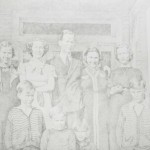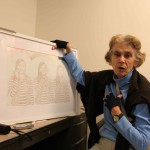Walnut Hills artist Constance McClure sometimes subconsciously sketches in the air when she’s deep in conversation.
Drawing always came naturally, but by now it’s automatic. She’s been creating art – starting with drawing, and moving on to painting, metalpoint and frescoes – each of her eight decades on earth.
Once among a large lunchtime crowd near St. Mark’s Square in Venice she was painting a watercolor, enthralled by the gondolas and candy-striped poles. Eventually, she realized: “There was nobody with me. I was sitting there all alone. I didn’t even know that all these people had disappeared. I was so caught up in it.”
From a humble birthplace in West Virginia to painting watercolors on the streets of Rome, McClure, 80, has lived an art odyssey that has included four decades of teaching at the Art Academy of Cincinnati, with earlier stints at what was then the College of Mount St. Joseph and Xavier University.
Twenty-two of her works are in the Cincinnati Art Museum’s collection.
She was born in 1934, deep during the Depression, in a tiny house owned by the former 18th Street Mission in Huntington, W.Va., which her laid-off father was managing.
“My mother was an avid reader. She said it kept her from being six feet under,” McClure said. “We always had books. And I used to draw in those, you know those first couple of pages that are empty? And they let me. And then I even had a tablet. I wish I had that. It got lost because we moved all the time.”
She does have a couple of drawings she created when she was about 10, one of her mother napping on the couch, another of roses on the mantel. “They hold up pretty darn well,” she said.
“I was encouraged, and my father used to draw a cartoon,” she said. “And I can remember him saying, ‘I really wish I knew how to draw.’ And the art meant something.”
From those Depression-era sensibilities McClure has fashioned a career of realistic drawings and frescoes, mainly of the human form. Unlike older frescoes with more classical themes of aristocrats, angels and saints, hers have tended toward portrayals of ordinary people. Among her subjects have included local bus drivers, security guards and house painters.
A Long Way to the Art Academy
After graduating from high school in Huntington, her drawing skills gained her work for two years designing weekly grocery-store ads that went to customers in the coal fields of West Virginia, Kentucky and Ohio.
Her father, Morton B. McClure, was a machinist for the Chesapeake & Ohio Railroad, a job that allowed families to apply for “foreign passes,” which let them travel via other railroad companies to cross the country. Her mother, Orca (Graves) McClure, loved those trips and applied whenever possible. One year, the journey was given to her daughter because “Orsey” McClure somehow found out about the small Ringling School of Art, in Sarasota, Fla., where the circus of the same name has its summer home.
“When I was there we used to go draw at their training grounds, where all the elephants and stuff were,” she said.
In Florida she married Ringling schoolmate Robert McNesky, an affable Korean War Marine staff sergeant and Silver Star recipient who painted and later became a full-time sculptor.
She was due to have her first child, and in mid-20th century America, “you did not go to art school when you were pregnant,” she said. “You stayed at home and knitted and all that. That was the thinking. That’s why way later I became a red-hot feminist.”
The young family moved from Florida back to McClure’s family in Huntington, and later to Cincinnati, where McNesky in the early 1960s earned his master’s degree and later started teaching at University of Cincinnati’s College of Design, Architecture and Art, or DAA, before the program’s name changed to DAAP.
“He was a schmoozer,” she said. “He knew the right people. He knew who to introduce himself to. Back when there was no Internet it was getting something in the paper and being with whom. He was always getting his picture in the paper or in UC news.”
McNesky talked a wealthy Cincinnati family into sending him and his family abroad for a year in 1967 to study the lost-wax process of bronze sculpture. “So we ended up in Athens, Greece, for a year.”
It was one of several European travels for her, which have included England, Florence, Milan, Venice and Portugal. Some of her most popular works were watercolors she created on the streets in Rome.
“I thought, ‘I want to go back and get my degree. I want to teach. And I want to do my art. I want to be known as me. And that’s when I started using my name, McClure.’ Instead of Connie McClure McNesky, it was Constance McClure,” she said with a chuckle.
Most of her friends today call her Connie, except for those who enjoy saying Constance.
One day a friend called to tell her Sister Augusta Zimmer at Mt. St. Joseph “wants someone to teach drawing, because their students graduate with an art degree, and they only have one year of drawing.” McClure had just had a show of her silverpoints at the Closson’s art gallery.
“So Sister Augusta hired me right out,” McClure said. “I was using my own name, and I was the first one to use a pants suit. She was wearing a habit. She was one cool nun.”
McClure would earn her bachelor’s degree in art (1971) at the college while teaching drawing.
“I wanted to use my own name, but the office said, ‘No, you’re married.’ So I told Sister, and she said, ‘No, Georgia O’Keeffe’ – because she studied in Chicago, at the Art Institute school. “She said, ‘No, you should use your own name. Because your husband’s an artist, and you’re an artist. She was super cool.”
Another McClure milestone at the Mount: “I brought in the first nude model,” she said – before whispering – “a black guy.”
She knew the man through McNesky’s teaching at UC. Rather than being shocked, Sister Augusta “was supportive of that,” being familiar with the ways of art schools.
“You see, the building was over by itself, and anybody on the campus would have been aghast, because there’s a naked … person … over there, and they’re drawing him,” McClure said, slyly.
After graduating from Mt. St. Joseph she wangled her way into the University of Cincinnati’s master’s in fine arts program with the help of an administrator who eased her in first as a part-time panel on the provision that she would later be accepted by a faculty panel. “So I ended up getting my degree (in 1974) when I was 40,” she said.
More luck helped her begin teaching classes at the Art Academy of Cincinnati in the fall of 1974. There were no openings, but she was invited to be a substitute for a teacher who was trying to emigrate from Great Britain.
“I said, ‘Sure.’ And I’ve been at the Art Academy ever since,” she said. “By the time he got here I’d already taught in his place for a year. I taught night school, I taught everything, stuff I didn’t even know how to do.”
She and McNesky divorced “during hippie times,” and he died in the early 1990s.
Modern Realism, Traditional Methods
McClure, someone who always has tried to depict things as she sees them, has always been drawn to realism – with some of her paintings and frescoes looking like old photographs.
Feeling pressure from artistic peers during the early 1980s, she briefly tried something completely different.
“I did some abstracts – three big ones,” she said. “I think I showed them once and then I threw them in the trash. I literally tore ‘em off the stretchers and threw ‘em in – it was where John Haney’s framing used to be, on Gilbert – and put ‘em in the dumpster in back. I said, ‘This is not me’.”
“There was a lot of pressure at school and elsewhere to be abstract,” she said. “People had the attitude, “This is not art. You don’t do that anymore.”
To which she responded, “Like hell you don’t. They want to skip the basics. They want to go right to – and that’s why I call it the ‘fling paint school’.”
It’s all about traditional materials in the classes she teaches, although students are invited to experiment. And it’s difficult to tell where the mother of three draws more satisfaction. From the art she creates? Perhaps it’s from the two classes – Drawing 3, or traditional materials and techniques, where she has students creating works in metalpoint, egg tempera, hand-ground oil paints, encaustic and small fresco panels.
One advantage of egg tempera, she tells students, that it lasts “way longer” than oils. “But the longest lasting, barring earthquake and eruption, is fresco.”
It’s also, by far, the most difficult way to paint. It’s how Michelangelo painted the Sistine Chapel’s ceiling, seven days a week, with the Pope Julius II directing him to ignore the Commandment about observing the Sabbath day.
McClure, who one year had an exhibit on every floor of the Cincinnati Art Museum – including the storage level and the library – herself creates all seven days.
- 1937, 1974, pencil on primed linen, 78 18 x 100 18 in. (198.4 x 254.3 cm), Gift of the Fleischmann Foundation to the Cincinnati Art Museum in memory of Julius Fleischmann, 2000.330
- Isotelus I. Maximus, 1974, pencil and colored pencil, 11 716 x 9 in. (29 x 22.8 cm), Centennial Gift of the Fleischmann Foundation to the Cincinnati Art Museum in memory of Julius Fleischmann, 1981.264a-b
One recent Wednesday afternoon, while at the art academy, McClure explained what she planned to do after work.
“Today I will go home and at least an hour, hour-and-a-half, I will either draw, and I’m doing one of the St. Mary’s steeple out of a scrap piece. I keep a sketchbook all the time, and I don’t know what the heck I’m going to do with all this junk. When I die, my kids are stuck with it.”
In the meantime, many of her works are on permanent display at Haney Custom Framing, 2371Kemper Lane, in Walnut Hills.
“It gives me peace, it gives me quiet,” she said, before recalling a quote: “‘Art is our refuge from adversity.’ Who said that?”
Just as “Orsey” McClure had her reading, Constance has her art.
“Well,” McClure said, “I say I’m going to die at my easel, kind of thing.”
–Mike Rutledge










